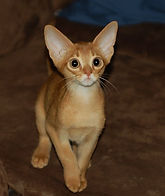


Kahali Cattery


Abyssinian
About the Breed
Although the Abyssinian is one of the oldest known breeds, there continues to be speculation and controversy concerning its history. In appearance, Abyssinians resemble the paintings and sculptures of ancient Egyptian cats which portray an elegant feline with a muscular body, beautiful arched neck, large ears and almond shaped eyes. Abys today still retain the jungle look of felis lybica, the African wildcat ancestor of all domestic cats.
The source of the name is not because Ethiopia, formerly Abyssinia, is thought to be the original home of these cats, but because the first “Abyssinians” exhibited in shows in England were reported to have been imported from that country. The first mention is in the Harper’s Weekly (January 27, 1872 issue) where the 3rd prize in the December 1871 Crystal Palace show was taken by the Abyssinian Cat “captured in the late Abyssinian War.” This article is accompanied by an illustration of the Abyssinian Cat. In the British book, by Gordon Stables, Cats, Their Points, and Characteristics… published in 1874, there is also mention of an Abyssinian. The book shows a colored lithograph of a cat with a ticked coat and absence of tabby markings on the face, paws, and neck. The description reads: “Zula, the property of Mrs. Captain Barrett-Lennard. This cat was brought from Abyssinia at the conclusion of the war…” British troops left Abyssinia in May 1868, so that may have been the time when cats with ticked coats first entered England. Unfortunately, there are no written records tracing the early Abyssinians to those imported cats, and many British breeders are of the opinion that the breed was actually created through the crossing of the various existing silver and brown tabbies with native British “Bunny” ticked cats.
Recent studies by geneticists show that the most convincing origin of the Abyssinian breed is the coast of the Indian Ocean and parts of Southeast Asia. In fact, the earliest identifiable Aby is a taxidermal exhibit still residing in the Leiden Zoological Museum in Holland. This ruddy ticked cat was purchased around 1834-1836 from a supplier of small wild cat exhibits and labeled by the museum founder as “Patrie, domestica India.” Although the Abyssinian as a breed was refined in England, its introduction to that country and others may have been the result of colonists and merchants stopping in Calcutta, the major port for the Indian Ocean.




Ruddy
Red
Blue
Fawn


